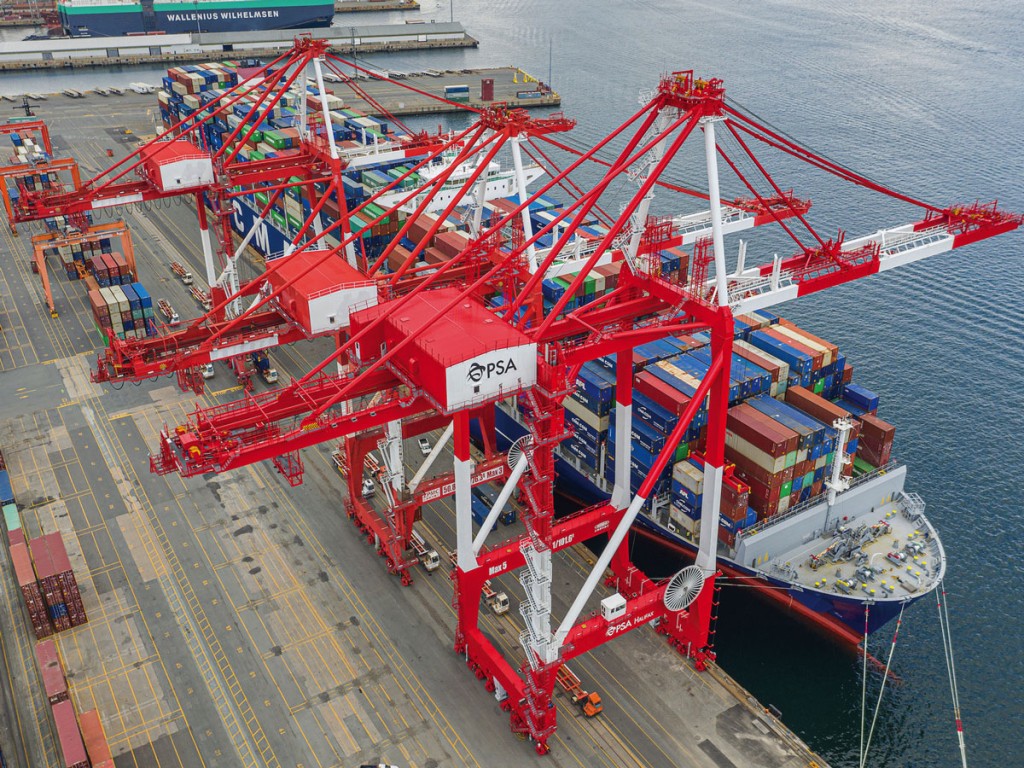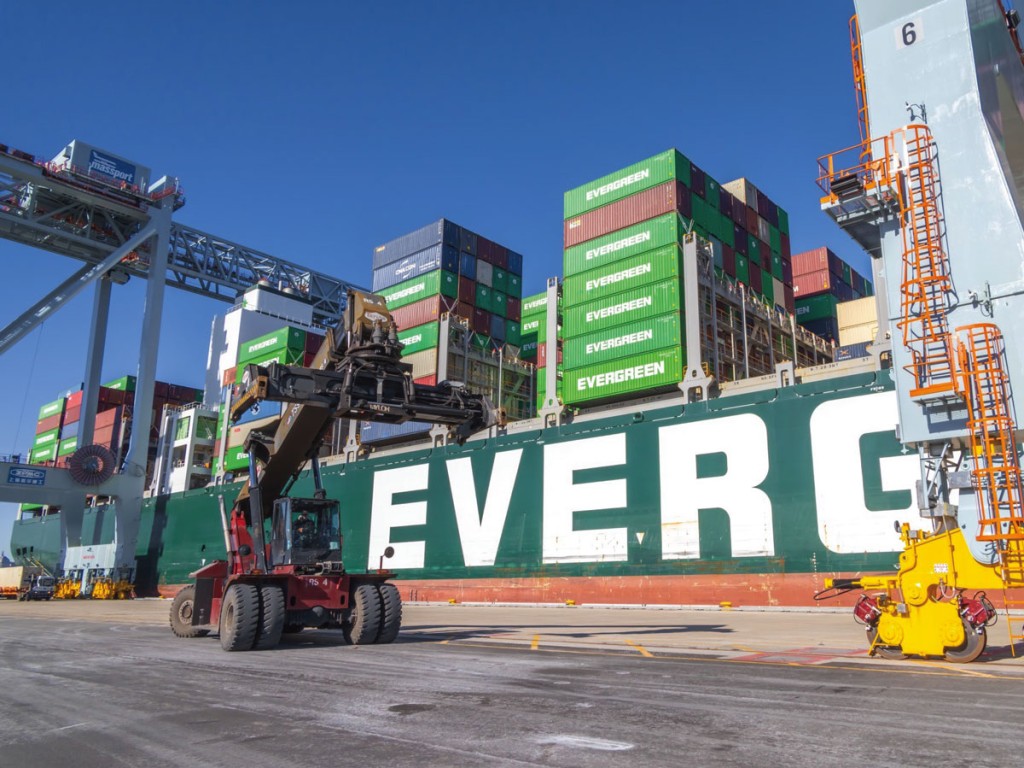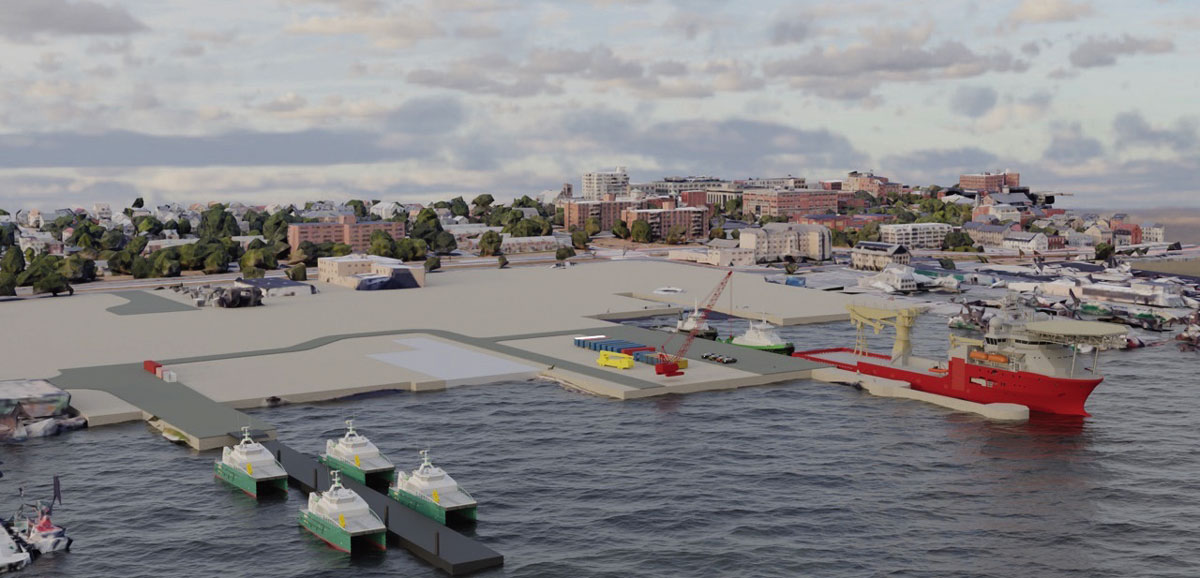Northeast ports are building with purpose as new infrastructure takes shape and new business opportunities appear with offshore wind power.
One observable indication of business going well is the ordering of new equipment. And nothing is quite as “observable” as a gantry crane. Port of Halifax, Nova Scotia, PSA Halifax, part of the Singapore-based PSA International group, arguably the largest terminal operator in the world, ordered two additional Super Post-Panamax ship-to-shore container gantry cranes. The cranes are due for delivery in early 2023 to the PSA-Halifax’s Atlantic Hub terminal. The new Super Post-Panamax ship-to-shore cranes have an outreach of 24-wide making them capable of spanning the largest vessels being deployed along the North American east coast. The cranes will be added to PSA Halifax’s main berth alongside the five Super Post Panamax cranes currently deployed at the terminal.

2021 was a good year for the Port of Halifax, not that 2020 was a bad year. Both imports and export TEUs were up (302,912 +16.8% and 292,839 +17.2%). The total was a good sign as they hadn’t eclipsed 550,000 TEU since 2017 (559,242 TEU). In a release, Jan Van Mossevelde, CEO, PSA Halifax tidily summed up the advantages of the Port by stating: “As the first port of call on North America’s east coast for ships transiting the Atlantic from Europe and South Asia, PSA Halifax offers an uncongested gateway for importers in Canada and the United States…”
Besides the location, The Port of Halifax’s main calling card is the on-dock-rail which enables cargo to be shifted quickly to markets to the West – particularly the U.S. Midwest. The Port also received an unexpected boost when labor strikes in the rival Port of Montreal in 2021 also resulted in a portion of Hapag Lloyd’s volumes being rerouted to Halifax.
In many ways the Port of Montreal is considered the gateway to the U.S. Midwest. The Port’s location over a thousand miles up the Saint Lawrence River from the Atlantic has always been an advantage, albeit weighed against the river’s depth and ice during the winter. The problem in recent years is that the Port’s terminals are nearly maxed out. In 2021, Montreal posted 1,728,114 TEU and the overall capacity for the Port is estimated at 2.1 million TEUs. And it is estimated by 2026 the Port will hit terminal capacity. In November of 2021 at a “technical briefing” the Port updated its procurement process to enable bidding on building and setting a timetable for the Port’s sixth container terminal. Now, assuming there are no hiccups, timeline marks the scheduled operational date for late 2026 versus the original date of 2025. The location for the new terminal is at Contrecoeur – 25 miles downstream on the St. Lawrence River – where there is already bulk shipping activity. Leo Ryan, AJOT’s Canadian correspondent, wrote of the new deal: “Upon completion, the terminal will be able to handle 1.15 million TEUs and will boost the port’s capacity from 2.1 million TEUs to 3.5 million TEUs.”
Actual construction would begin in 2023. The facility will be able to accommodate vessels between 39,000 DWT and 75,400 DWT. The Canada Infrastructure Bank has provided $300 million for the project while the Quebec Government is adding another $55 million grants. (Montreal Gateway Terminal) and Termont (Logistec group), the port’s two main terminal operators, have been holding discussions on a possible joint venture in the new facility. Although given the entry of players like PSA International (see above) to the Canadian market, options for an outside terminal operator are still wide open.
In New England a number of ports are looking at projects to lift their future prospects. For example, the Port of Portland, Maine which is served by the Icelandic carrier Eimskip, the Icelandic carrier has for years tried to get a refrigerated warehouse facility built on the Port’s waterfront. Back in 2015 Americold was going to develop a cold storage facility, but they eventually pulled out of the project in 2018. Recently the project was revived as Treadwell Franklin Infrastructure and Amber Infrastructure teamed up with Eimskip to develop a 120,000 sq/ft temperature-controlled facility on the state-owned property located next to the International Marine Terminal. The deal’s structure is that the State of Maine would lease the land for a 50-year period to the developers of the cold storage facility. Ideally, the facility would provide a hub for Maine’s cold storage businesses that now rely largely on facilities based in Massachusetts.

The Port of Boston which is the largest container port in New England has been preparing to be “Big Ship Ready” since the Panama Canal’s expansion back in 2016. So, when the container ship Ever Fortune arrived in the Port of Boston and berthed at Massport’s Conley Terminal in South Boston on January 16, 2022, it became the largest containership ever to call at the Port. More than a maritime milestone, the ship call represents a real-time testament to the Port of Boston’s “Big Ship” capabilities. The two-year old Ever Fortune is one of Taiwan-based Evergreen Marine’s F-Class ships and is 1,096-feet long, 159-feet wide, enclosing 19-container cells across, designed to hold 12,100 TEUs with a maximum loaded draft of slightly over 50-feet. For Massport, demonstrating the ability to handle line haul size vessels is key to attracting and keeping liner services to the Port. And in March Massport was able to attract a highly sought after new service to Vietnam. ZIM Lines will deploy a bi-weekly service connecting Southeast Asia with the Northeast U.S. The new service will link South China and Vietnam to Boston via the Suez Canal. This is an important connection for the Port as South China and Vietnam are two key regions for local importers.
The Port of Boston is surrounded by larger port competitors like Halifax, Montreal, and New York/New Jersey not to mention the impact on vessel rotation from other East Coast competition like the Port of Virginia (which just added to new gantry cranes to the Norfolk International Terminal), Baltimore and Philadelphia. However, the high-income and general prosperity of the region is a magnet for high-value imports which in turn attracts direct ship calls. But the draw of the larger ports makes the Port of Boston vulnerable to bypass as liners try to balance schedules against congestion and other supply chain issues. The call of the Ever Fortune is in a sense a counter argument, as Boston has no congestion and can clearly handle the larger vessels.
Impact of Offshore Wind Power
By far the biggest influence on Northeast ports is the burgeoning offshore wind power industry. It stands to represent the largest investment in U.S. ports and the maritime sector since World War II and it is starting in the Northeast from Maine to New York and New Jersey and into the mid-Atlantic states. (see Buxbaum article on page 8) Every Northeast state (and port) is looking at what offshore wind power can do for their economy. Like prospectors on a gold rush, not every port is going to succeed in establishing itself as a hub for offshore wind power operations, but there is a great democracy in opportunity for ports large and small to participate in the offshore wind power sweepstakes. Some of the ports like Rhode Island’s Port of Davisville (see box on page 8) got out of the gate early while others are jumping in as newly awarded Federal and State offshore tracts point to business opportunities. And this contrasts mightily to the container terminal business, with its massive financial and physical demands.
Take for example the case of the Port of New Bedford. Mostly known as a fishing port, New Bedford got into the offshore wind power industry early. And recently the Port received a big boost with the announcement of the building of a new terminal dedicated to serving offshore wind power.

The new facility is to be built on the former Sprague/Eversource and will be in redevelopment over the next year and be renamed the New Bedford Foss Marine Terminal. The redeveloped terminal is expected to open in March of 2023. And will provide storage and laydown yards for equipment and materials, berth facilities for tug and barge operations, and host crew transfer vessel (CTV) and service operation vessel (SOV) support services. It will also create new office space for project teams and a marine coordination center for technicians involved in offshore wind projects. Foss is partnering with key local investors of New Bedford’s Cannon Street Holdings LLC (CSH) to develop the 30-acre site. Andrew Saunders, local commercial offshore marine industry attorney with Cannon Street Holdings, will serve as President of the New Bedford Foss Marine Terminal. Saunders commented at the announcement, “The repurposing of this facility to support offshore wind has been a vision for many and it is great to see this project now begin to materialize.”
Foss Maritime, based in Seattle, is one of the best know tug and barge operators on the West Coast. Foss is part of the Saltchuk group of companies that specialize in harbor services and marine transportation.
Another maritime company that has invested heavily in marine development is the Carver Companies based in the Coeymans, New York. Although the Port of Coeymans isn’t a household name – located about 10.5 miles south of the Port of Albany and 140 miles north of New York on the Hudson River – the Port is known for its ability to handle project work. And the Carver Companies, owner and operator of the Port handle the stevedoring and operate the marine terminal. The Port area has some 450 acres of industrial space, a 750 foot pier with 30 foot draft. In October of 2021, the Port got a big boost when New York Governor, Kathy Hochul announced the Port of Coeymans would become the second major assembly point for the wind turbine structures for New York’s Sunrise Wind offshore wind project – part of the State’s goal to develop at least 9,000 megawatts of offshore wind by 2035.
Ørsted and Eversource, Sunrise Wind’s joint development partners, signed a $86 million supply chain contract with Riggs Distler & Company, Inc. to construct advanced foundation components for wind turbines at the Port of Coeymans. Once complete, the components will be shipped down the Hudson River and out to the Sunrise Wind offshore wind farm site, located in federal waters roughly 30 miles east of Montauk Point, N.Y. located off Long Island.
The neighboring Port of Albany is also vested in developing a staging area for the New York’s offshore wind power. Back in 2018 the Port began the process of moving into the offshore wind sector and last year the Port of Albany was selected as the first offshore wind tower manufacturing site. The project is built around the development of the adjacent 80-acre expansion site located in the Town of Bethlehem. The property will be utilized by a joint venture between Marmen Inc. and Welcon A/S with partner Equinor Wind US LLC who will lease the entire site to fabricate offshore wind towers. In December pf 2021 it was announced that the Port of Albany also secured $29.5 million in building funds through the U.S. Department of Transportation’s Maritime Administration (MARAD) Port Infrastructure Development Grant program. Components of the project will include a new state-of-the-art wharf, a new bridge, new and improved internal roadways and more than 600,000 square feet of manufacturing space in four buildings. The finished offshore wind assemblies will be shipped via the Hudson River offshore wind development sites such as the one off Long Island (see above). But the site will have the capacity to supply offshore wind projects along the entire Eastern Seaboard. The Port of Albany is reportedly looking at adding other sites to the landside portfolio for further expansion of offshore wind power activities.
Enstructure, the parent company of Gateway Terminals and a number of other terminal and related investments also has taken a position in the Northeast’s offshore wind power business. Back in 2019 Gateway New London (Connecticut) was chosen as the Terminal Operator for the New London State Pier with a 20-year concession agreement with the CPA (Connecticut Port Authority) with the intent to redevelop the pier into a new terminal dedicated to offshore wind. Subsequently, Gateway Terminal, Ørsted, and Eversource inked an agreement on a harbor development plan for State Pier in New London to rebuild the pier into an offshore wind power center to support their activities. Gateway also operates a facility of around 75 acres in the Port of New Haven.
At the moment the Port of New London is undergoing a $235 million rebuild after a number of delays and cost increases to the project and is now set for completion in 2023.





